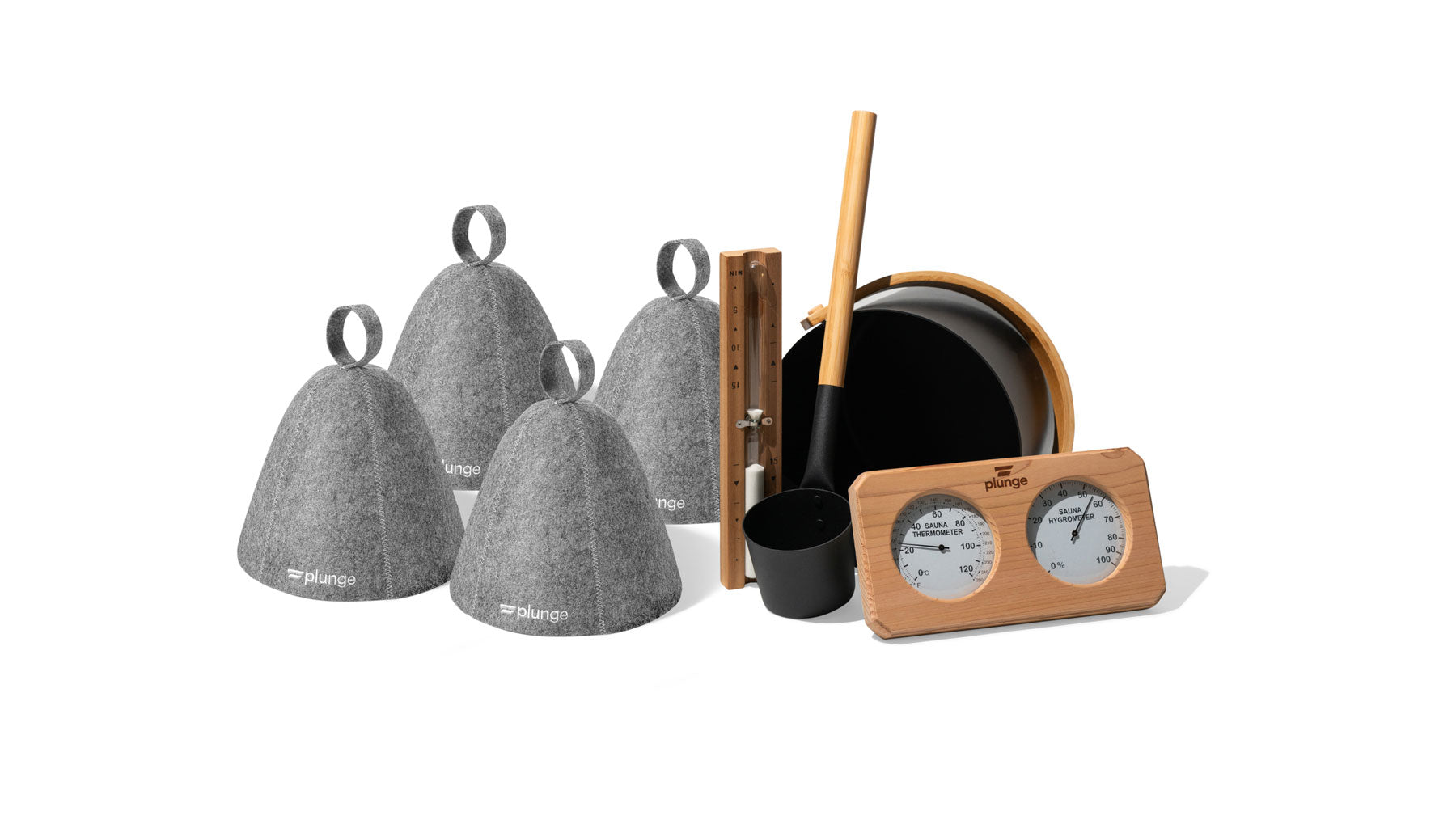
Benefits of a Steam Room vs. Sauna: What Are the Differences?
It’s widely recognized that heat therapy offers numerous health benefits. Visiting a sauna or steam room subjects the body to elevated temperatures, prompting perspiration, which plays a crucial role in detoxifying the body. Additionally, the heat and steam can foster relaxation, reduce muscle tension, and enhance blood circulation.
Many use the terms interchangeably, but saunas and steam rooms are actually different. Unsure of the difference between a steam room vs. sauna or when to use each? In this guide, we’ll explore the two, uncover the benefits of each, and go over some frequently asked questions so you can find the best option for your needs.
Explaining Saunas & Steam Rooms
Not only are saunas and steam rooms great tools for relaxation, heat therapy, and post-workout recovery, but they can also improve cardiovascular health, boost your immune system, and lower your blood pressure.
Compared to steam rooms, saunas have a dry heat. Some sauna types use lamps to create infrared heat and warm your body directly, without warming the air within the sauna. However, most traditional saunas use a closed stove or sizzling rocks to warm the air. Customary Finnish saunas are heated to between 150°F and 195°F, while the average infrared sauna will be heated to roughly 180°F to 195°F.
On the other hand, steam rooms are created using boiled water and will feel tropical-like, with humidity levels between 95% and 100%. Additionally, most steam rooms are only heated to between 114°F and 120°F, making them cooler than saunas. However, you probably won’t notice the difference very much due to the increased humidity.
Whichever you choose, it’s important to stay hydrated before and after your sessions, as both can cause dizziness and dehydration. Have a bottle of water ready, and don’t overdo it! Spending too much time in a sauna or steam room can lead to overheating, dehydration, and blood pressure fluctuations. Beginners should limit sessions to 5 to 10 minutes, while those who are more experienced can go up to 15-20 minutes.
Differences Between a Sauna vs. Steam Room
Now that we’re clear on what steam rooms and saunas are and some of their similarities, let’s dive into how they set themselves apart. Remember that saunas are generally hotter but less humid than steam rooms, though you may have difficulty discerning the temperature difference due to how high humidity levels affect “feels-like” temperature. Conversely, the humidity in a sauna hovers around around 10%, but sprinkling water onto hot rocks can produce water vapor and push humidity past 60%.
In terms of session duration, steam rooms can generally accommodate slightly longer sessions, compared to the more brief durations recommended for saunas.
While saunas tend to offer a dry heat experience that some people find invigorating and detoxifying, steam rooms take a different approach — creating a high-humidity environment that can help provide deep relaxation and a sense of calm while also clearing your airways. However, this additional moisture means steam rooms need to be properly maintained to eliminate the presence of bacteria and mold.
Because saunas can get much hotter than steam rooms, they may pose more of a concern for certain demographics. This includes seniors, pregnant women, and those taking medications that hinder the body from properly regulating its temperature. If you’re unsure if saunas are safe for you, consider speaking with a healthcare professional first.
Sauna Benefits vs. Steam Rooms
Saunas offer a unique set of benefits that distinguish them from steam rooms. One of the standout advantages of saunas is their ability to provide a dry heat experience. Unlike the high-humidity environment of steam rooms, saunas provide a deeply penetrating, dry heat that can promote muscle relaxation, soothe joint discomfort, and boost blood circulation and metabolism.
Sauna usage can also improve cardiovascular health, alleviate stress and anxiety, and improve skin health. Spending time in a sauna has been shown to improve your sleep quality so you can enjoy more restful nights. Plus, the dry heat in saunas can lead to an intense sweating experience, aiding in detoxification and removing impurities from the body.
Additionally, those seeking a more invigorating and stimulating environment may prefer saunas, as the higher temperatures can help improve blood circulation and metabolism. For individuals looking to enjoy warm, dry, and revitalizing heat therapy, saunas offer a unique and appealing option that steam rooms cannot replicate:
- Pain relief for sore muscles and chronic conditions
- Better blood circulation
- Improved metabolism
- Lower cortisol levels
- Less stress
- Healthier skin
- Improved sleep quality
- Detoxification
- Improved cardiovascular health
When to Use a Sauna
Saunas can be particularly helpful after a strenuous workout or stressful week, as the heat can relax and loosen your muscles, promote better circulation, and flush out toxins, accelerating recovery. However, you don’t need a specific reason to go! You can stop by the sauna as part of your regular wellness routine, as consistent sauna usage has been associated with various long-term health benefits, including improved cardiovascular health, stress reduction, and enhanced immune system function. Even better, you can pair a sauna with an ice bath to experience the full benefits of contrast therapy.
Whether you’re visiting the sauna post-workout, during a stressful period, or just because, limit your sauna time to 20 minutes at a time. Remember to listen to your body and drink plenty of water!
Steam Room Benefits vs. Saunas
Like saunas, steam rooms can help with muscle soreness and recovery, joint pain, and skin health. Given their high humidity levels, steam rooms can also help you fight off congestion in your lungs and sinuses. The steamy environment warms up your mucus membranes and encourages you to take deeper breaths, both of which can loosen phlegm and lessen congestion. Other benefits include:
- Pain relief for sore muscles and joints
- Faster muscle recovery
- Healthier skin
- Less phlegm and congestion
When to Use a Steam Room
Next time you’re heading to the spa, consider kicking off your day with a quick trip to the steam room. Steam rooms are also great before or after workouts. By stopping by the steam room before exercising, you can relax your muscles, leading to maximum flexibility and mobility during your training. Hitting the steam room after your workout can help you stretch out and loosen your muscles, resulting in a better recovery. Again, keep your steam room trip to under 20 minutes, and avoid drinking alcohol before you go.
Steam Rooms vs. Saunas FAQs
Should You Go in the Sauna or Steam Room First?
When it comes to choosing whether to enter the sauna or steam room first, there’s no hard and fast rule. Some people love to hit the sauna first and end in the steam room for deeper relaxation, but others prefer to head to the steam room and follow it up with a visit to the sauna. It all comes down to your personal preference.
How Long Should You Stay in a Steam Room vs. a Sauna?
Whether you visit a steam room or a sauna, try to keep your visit to under 20 minutes. For those new to saunas, it’s recommended to keep your session below 10 minutes due to the high temperatures. However, remember that it’s also easy to accidentally overstay in a steam room, as you may not realize how hot you have become due to the slightly lower temperatures but higher humidity.
Is a Sauna or Steam Room Better for Weight Loss?
While saunas and steam rooms can help with weight loss, neither is a shortcut to shedding pounds. Sure, they can help you lose some water weight through sweat, but that likely won’t result in much long-term weight loss, as you’ll still need to drink plenty of water throughout your sauna or steam room session. To lose weight, you need to combine sessions with regular exercise and a proper diet.
Steam Room or Sauna? How to Decide the Best Heat Therapy for You
Saunas and steam rooms have plenty to offer, but saunas often go a step further, helping with cardiovascular health, circulation, cortisol levels, and detoxification, in addition to muscle relief, stress, and skin health. Ultimately, when choosing between the two, you’ll want to think about your specific wellness goals and preferences in environment.
If you’re ready to have all the benefits of a sauna without leaving your house, check out our at-home sauna, an innovative product made with premium materials like incense cedar and featuring a maximum temperature of 230°F. With the easy-to-assemble construction, you’ll have fully customizable accent lighting and precise control via our mobile app, enabling you to create a truly relaxing (or invigorating) experience.
























